 06 May
06 May
Are you building an online store and feeling overwhelmed by the sheer amount of design choices? Creating a visually appealing, user-friendly website that converts visitors into customers requires more than just beautiful images. Choosing the right CSS framework can significantly impact your development speed, maintainability, and ultimately, your e-commerce success. Selecting the wrong one can lead to slow loading times, a clunky user experience, and wasted developer time. Let’s dive into the best options.
CSS frameworks provide pre-written code for common web design elements like navigation bars, grids, buttons, forms, and more. This dramatically reduces development time because you don’t have to write everything from scratch. They also promote consistency across your website, ensuring a professional look and feel. Furthermore, many modern frameworks offer responsiveness features, adapting seamlessly to different screen sizes – crucial for e-commerce where users browse on desktops, tablets, and smartphones.
Several CSS frameworks are popular choices for building e-commerce websites. We’ll focus on Bootstrap, Tailwind CSS, and Material UI, examining their strengths and weaknesses in the context of online retail. Each framework offers a unique approach to development, catering to different project needs and developer preferences.
Bootstrap is arguably the most popular CSS framework globally. It’s known for its ease of use and extensive documentation. Developed by Twitter, it was initially designed for internal use but quickly gained traction within the web development community. Bootstrap’s grid system makes creating responsive layouts incredibly straightforward. It boasts a huge community support network, meaning finding solutions to problems is usually simple.
Pros: Large community, extensive documentation, pre-built components, rapid prototyping, good for beginners. Cons: Can lead to larger CSS files (potentially affecting performance), can result in generic designs if not customized heavily, sometimes feels a bit dated compared to newer frameworks.
Example: Many large e-commerce brands, including ASOS and AliExpress, have initially utilized Bootstrap for their website development. Although they’ve likely made significant customizations over time, the initial framework provided a strong foundation.
Tailwind CSS is a utility-first CSS framework that provides low-level utility classes instead of pre-designed components. This approach offers maximum flexibility and control over your design. Instead of using classes like “btn” or “card”, you apply individual utilities like “bg-blue-500” (background color blue) and “p-4” (padding).
Pros: Highly customizable, minimal CSS footprint (resulting in faster loading times), promotes a unique design aesthetic, excellent for developers who want fine-grained control. Cons: Steeper learning curve than Bootstrap, requires more manual CSS writing, can lead to verbose HTML if not managed carefully.
Material UI is a React component library that implements Google’s Material Design system. It’s ideal for building complex e-commerce applications using React. It provides a rich set of pre-built components – buttons, navigation bars, data tables, and more – all styled according to the Material Design guidelines. Responsive design is built into its core.
Pros: Beautiful and consistent designs based on Material Design, excellent component library for React developers, strong community support, well-documented. Cons: Tied to React, can be overkill for smaller e-commerce sites, may require significant customization to deviate from the default Material Design look.
| Framework | Key Features | Learning Curve | Best For | Performance |
|---|---|---|---|---|
| Bootstrap | Grid system, pre-built components, responsive design | Easy | Beginners, rapid prototyping | Moderate (can be optimized) |
| Tailwind CSS | Utility-first approach, highly customizable | Medium | Experienced developers, unique designs | Excellent |
| Material UI | React component library, Material Design implementation | Medium | React developers, complex applications | Good (optimized React components) |
Selecting the most suitable CSS framework depends on several factors. Consider your project’s scale, your team’s skillset, and your desired design aesthetic. For small to medium-sized e-commerce sites with limited development resources, Bootstrap is often a good starting point due to its ease of use. If you prioritize performance and want a highly customized design, Tailwind CSS might be a better choice, especially if you have an experienced developer on the team.
For larger e-commerce applications built with React, Material UI offers a robust component library and adheres to Google’s Material Design guidelines. It’s important to factor in your website’s complexity – simpler sites may not need the full power of Material UI. Remember that responsive design is crucial for any modern e-commerce website regardless of the framework chosen.
A recent case study by Sitecore showed that e-commerce sites using optimized frameworks experienced an average 15% improvement in page load times, leading to higher conversion rates. Similarly, a Shopify blog highlighted how businesses leveraging Tailwind CSS reported significant design flexibility and control over their brand identity.
Choosing the right CSS framework is a crucial decision for any e-commerce website development project. Bootstrap, Tailwind CSS, and Material UI each offer unique advantages and disadvantages. Carefully evaluate your project’s needs and prioritize factors like ease of use, customization options, performance, and maintainability to make an informed choice. Investing time in selecting the right framework will pay dividends in terms of a faster, more user-friendly, and ultimately, more successful online store.
Q: Can I use multiple CSS frameworks on the same e-commerce website? A: While technically possible, it’s generally not recommended due to potential conflicts and increased complexity. It’s best to stick with one framework for consistency.
Q: How do I optimize CSS performance in an e-commerce website? A: Techniques include minifying your CSS files, leveraging browser caching, and using a CDN (Content Delivery Network).
Q: What are some resources for learning more about CSS frameworks? A: Explore the official documentation for each framework (Bootstrap, Tailwind CSS, Material UI), as well as online tutorials and courses on platforms like Udemy and Coursera.

0 comments